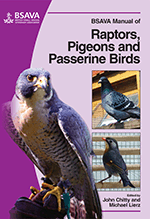
Full text loading...

Free-living birds tolerate their parasites but are not confined to a limited physical space, which means that their immediate environment is not subjected to an escalating level of contamination. This chapter explores ectoparasites, endoparasites and advice to clients.
Raptors: parasitic disease, Page 1 of 1
< Previous page | Next page > /docserver/preview/fulltext/10.22233/9781910443101/9781910443101.18-1.gif

Full text loading...

















